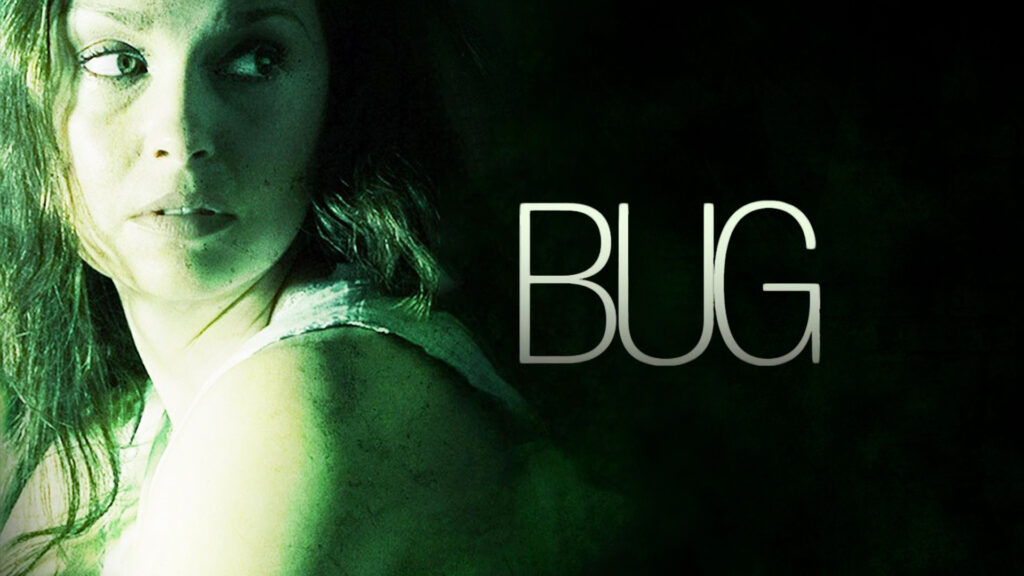If you’ve listened to a single episode of HPTV, you’re probably aware of my love of Art Bell and [fun] conspiracies. (Once you’re loading up a posse to storm a pizza parlor, you’ve lost me.) Bug is talked about frequently in conspiracy threads all across the interwebs, though in ways that are less fun and more of a get-your-gun-and-storm-a-pizza-parlor way. This marred the film for me, but I thought it would be a great film to cover for our creepy crawlies month. Another red X this film has going for it is something wholly personal and makes me a bit biased. If I had a nickel for every time I’ve watched an edgy theater kid in college (throughout four years of theater classes) do a scene or monologue from this film, I’d have like 20 nickels.
JUST BECAUSE YOU ARE LOUD AND DO ERRATIC MOVEMENTS DOESN’T MEAN YOU’RE ACTING.
Why Bug Stands Out in Horror Conspiracy Films
Bug tells a harrowing tale of the perils of mental health and conspiracy. Agnes (Ashley Judd) finds herself living in a rundown motel and constantly in fear of her incarcerated former partner, Jerry (Harry Connick Jr.). Things start to look up for Agnes when R.C. (Lynn Collins) introduces the mysterious but initially charming Peter Evans (Michael Shannon) into her life. Bug takes a sharp turn when Peter starts to share a theory that some government entity experimented on him during the war, which makes Peter go AWOL. What experiment did the government do to him? They filled him with…bugs!
Biases aside, Bug is one of the few films where I’m having trouble forming my opinion. To date, there has never been a film I both loved and disliked equally. Bug would mark the first collaboration between director William Friedkin and writer Tracy Letts, based on a play of the same name from writer Tracy Letts. This film walks the line between conspiracy and mental health. It stays fairly ambiguous throughout the entire runtime but eventually gives us a solid answer about one of the ambiguous ideas raised, and it feels incredibly cheap. If you spend considerable time leading the audience one way and then reversing that decision at the last moment with zero evidence to point that way, well, it’s careless.
Ashley Judd and Michael Shannon Shine in Bug
Two positive elements of this film work to save it from the depths of a pizza parlor’s sordid basement. Firstly, the film’s descent into madness. Secondly, the performances of Ashley Judd, Michael Shannon, and Lynn Collins (though it’s mainly Judd and Shannon). The characters are written in a way to foil each other perfectly, and the overwhelming majority of this film hinges upon the idea of social isolation so we are stuck with our characters in one location for 98% of the film. Judd and Shannon play off each other masterfully, and by the film’s final act, you cannot take your eyes off the screen. But again, the final act is ruined by Letts and Friedkin giving a solidified answer to questions that have been relatively ambiguous throughout the film. Shannon’s performance is most likely bolstered and fully realized by the fact that he played Peter Evans in the original, and subsequent stage performances of Bug.
Finally, the last aspect of this film is something that could go either way for audiences; this mainly worked for me but it’s easy to see how this could be a detractor for some audiences—the dialogue. Friedkin tries hard to make the film feel like a stage play. The dialogue is written and performed as if you were watching a stage play. Conversations overlap in a way that feels very community theater-like. Film typically doesn’t have constant overlapping dialogue, so if that’s something you’re not a fan of, then you’ll have a tough time making it all the way through.
Is Bug Worth A Watch?
Bug is a film that I think I’d possibly revisit with some other conspiracy friends, but that’s probably the only time I’d ever watch it again. Judd and Shannon give a masterclass in performing, it’s just ruined by one bad story decision. I’d be interested to see/read the original play to see where the film and the stage play share similarities and differences.
